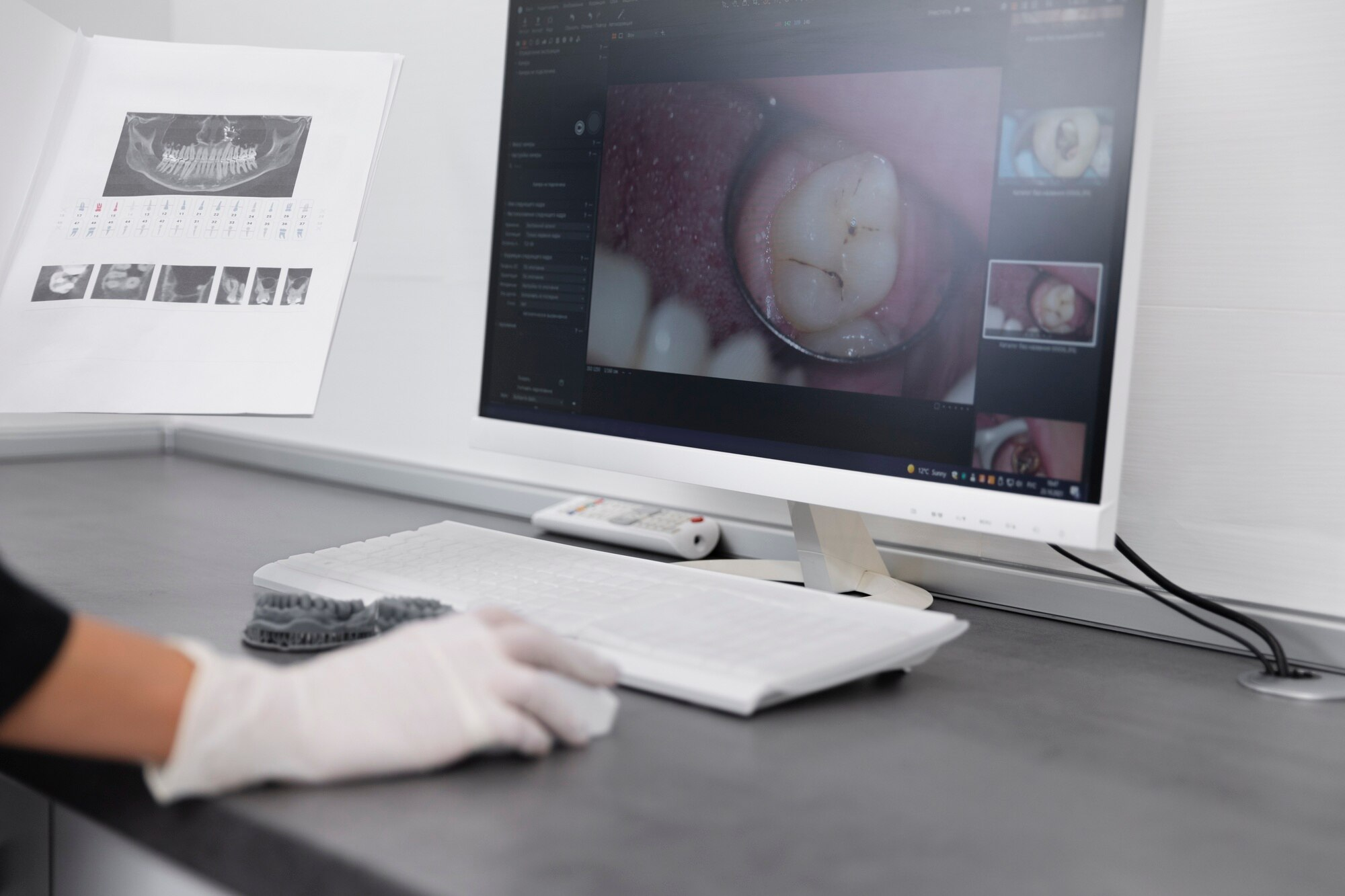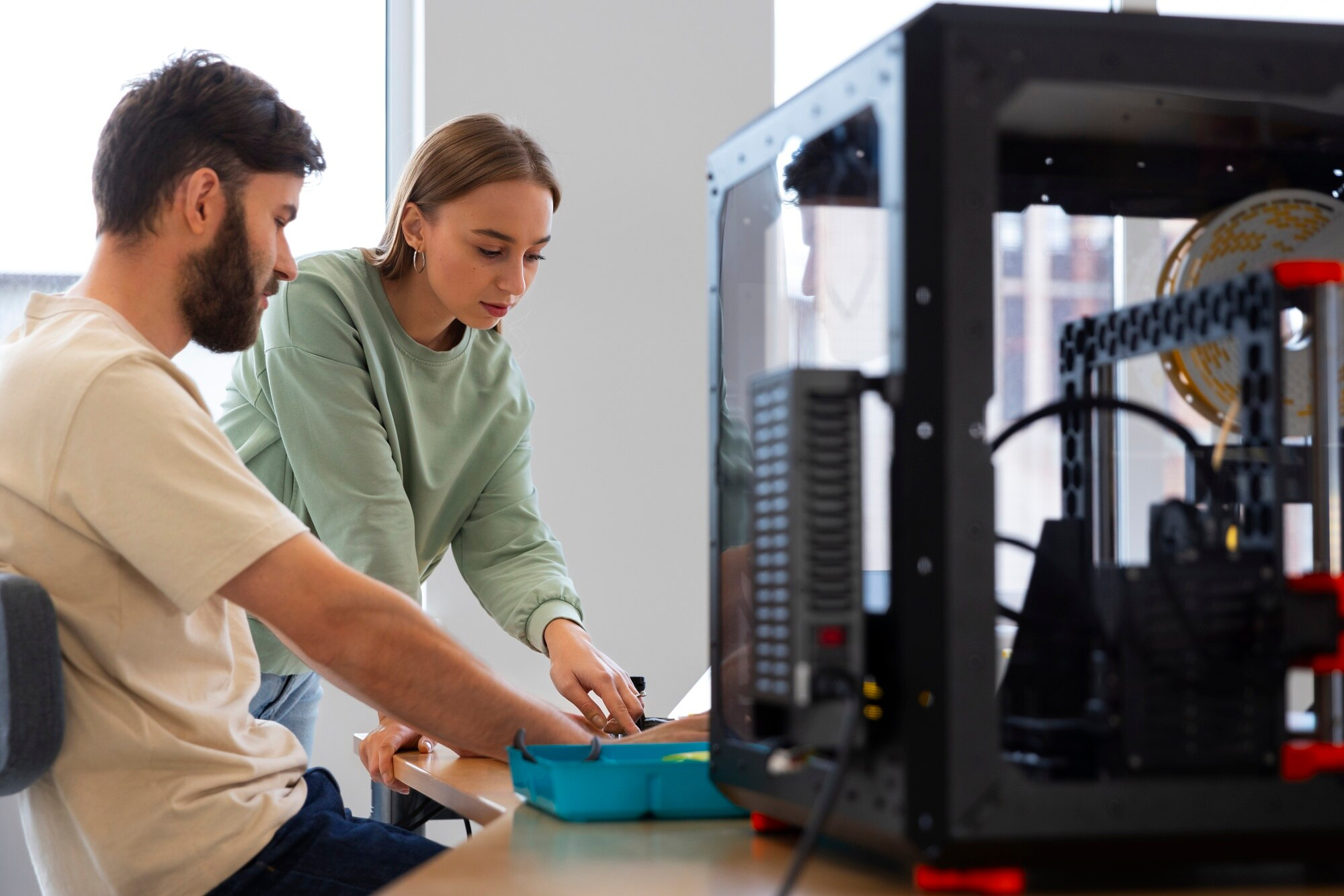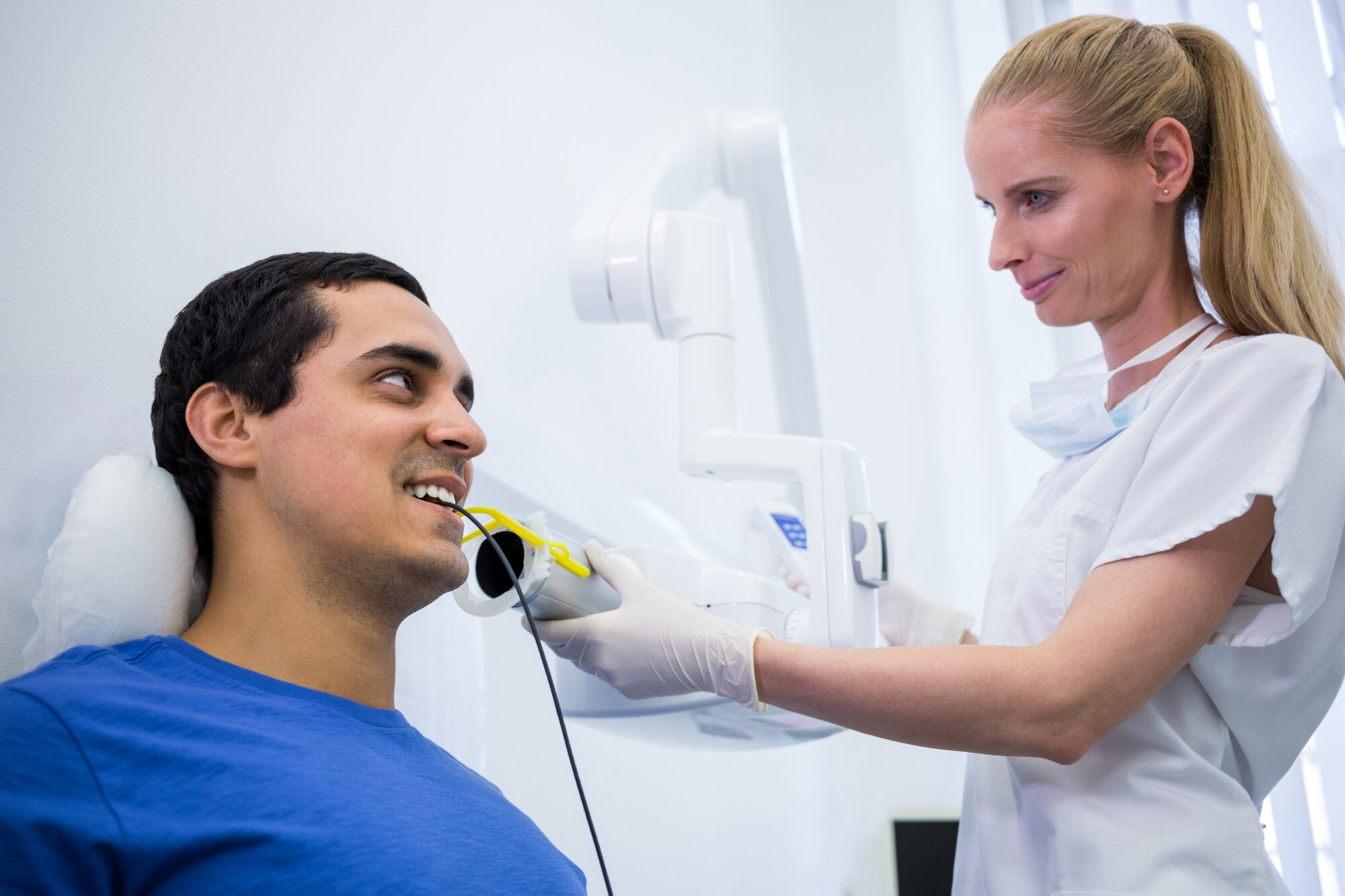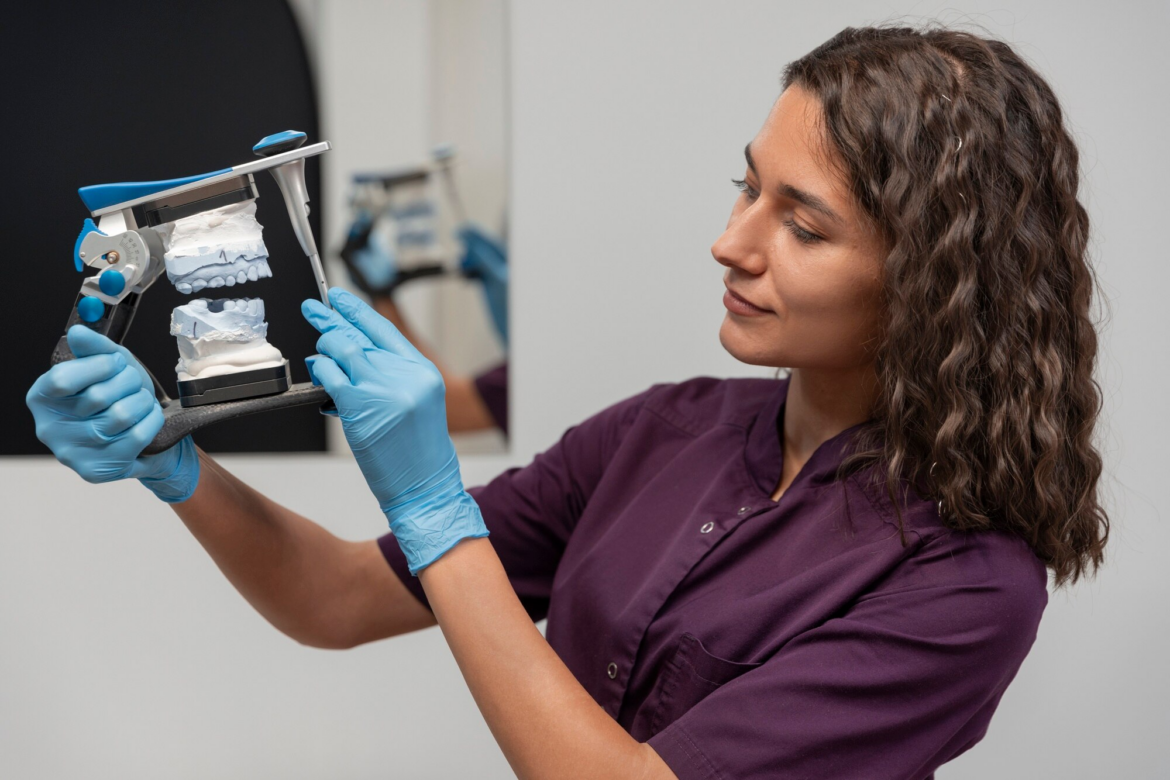Table of Contents
The integration of artificial intelligence (AI) in various industries has revolutionized traditional processes, bringing unprecedented efficiency and precision. Dentistry is no exception. The incorporation of AI in 3D printing for dental applications has significantly enhanced the quality of dental restorations, streamlined workflows, and improved patient outcomes. This article delves into the modern AI solutions in 3D printing that are transforming dentistry, with a focus on automated design of dental restorations, PRO-Craft’s AI integration, Dentsply Sirona’s Primeprint solution, digital dentures, and digital wax-ups.
Automated Design of Dental Restorations
AI’s role in the automated design of dental restorations marks a significant advancement in dental technology. Machine learning algorithms are employed to create highly accurate and aesthetic dental restorations such as crowns, bridges, and dentures. These algorithms learn from extensive datasets that include thousands of successful restorations and inputs from experienced dental technicians. By leveraging this data, AI can produce restorations that meet high standards of precision and esthetics while significantly reducing the time required for design.
The benefits of using AI in dental restorations are manifold. The most notable advantage is the minimization of human error. Traditional methods, reliant on manual labor, are prone to mistakes that can lead to ill-fitting or suboptimal restorations. AI, however, ensures consistency and accuracy in every design. Furthermore, this technology accelerates the process, allowing dental professionals to serve more patients without compromising on quality.
AI-driven automated design also allows for greater customization in dental restorations. Each patient’s oral anatomy is unique, and AI can tailor each restoration to fit these individual needs precisely. This level of customization enhances the overall patient experience, ensuring that the restorations are not only functional but also comfortable and aesthetically pleasing. As AI technology continues to evolve, it is expected to bring even more sophisticated capabilities to dental restoration design, further enhancing its accuracy and efficiency.
PRO-Craft’s AI Integration
PRO-Craft Dental Laboratory is at the forefront of integrating AI into dental restoration processes. Their use of AI-driven micro-CT scanning technology exemplifies how modern technology can enhance traditional practices. This technology transforms traditional dental impressions into high-precision digital models, significantly improving the accuracy and efficiency of the restoration process.
AI in PRO-Craft’s workflow ensures precise tailoring of dental restorations to the unique anatomy of each patient. The micro-CT scans provide detailed insights that guide the creation of custom restorations. This precision not only enhances the fit and comfort of the dental prosthetics but also ensures that they are aesthetically pleasing. Quality control is another area where AI shines, as it can detect minute errors that might be missed by human eyes, ensuring that every restoration meets stringent quality standards.
In addition to improving the accuracy and quality of restorations, PRO-Craft’s AI integration also streamlines the production process. The digital models created by the AI-driven micro-CT scans can be directly used in 3D printing, reducing the need for manual adjustments and significantly speeding up production times. This efficiency allows PRO-Craft to handle a higher volume of restorations without compromising on quality, ultimately benefiting both the dental professionals they serve and their patients.

Dentsply Sirona’s Primeprint Solution
Dentsply Sirona’s Primeprint solution is a game-changer in the field of dental 3D printing. This advanced system uses specialized resins to create flexible splints with minimal manual post-processing. The integration of AI in Primeprint ensures that each print is of the highest quality, combining optimal aesthetics and functionality.
One of the key advantages of the Primeprint solution is its ability to improve workflow efficiency. Traditional methods of creating dental splints often involve multiple steps and significant manual labor. With AI-driven 3D printing, these processes are streamlined, reducing the time and effort required from dental professionals. Additionally, the high-quality prints produced by Primeprint enhance patient comfort, as they are more accurately tailored to the patient’s anatomy.
The specialized resins used in Primeprint are designed to meet the specific needs of dental applications, providing both flexibility and durability. AI ensures that the resin is applied optimally during the printing process, resulting in splints that are not only functional but also comfortable for the patient. This integration of AI and specialized materials sets a new standard for dental splints, offering a combination of quality and efficiency that is hard to match with traditional methods. 
Digital Dentures
Digital dentures represent another significant advancement in dental prosthetics, facilitated by AI and 3D printing. Traditionally, creating dentures is a time-consuming and labor-intensive process that often involves multiple fittings and adjustments. AI, however, revolutionizes this process by using patient-specific data from scans to create digital models of dentures.
These digital models are then printed using advanced 3D printing technology, resulting in dentures that fit more accurately and comfortably than those produced by traditional methods. The use of AI in this process not only improves the fit and comfort of the dentures but also significantly reduces the turnaround time. Patients can receive their dentures faster, with fewer visits to the dental office.
Moreover, AI-driven digital dentures are more consistent in quality. The precise digital models ensure that each denture is crafted to exact specifications, reducing the likelihood of errors and ensuring a higher standard of care. This integration of AI and 3D printing technology in the production of digital dentures exemplifies the potential of modern technology to enhance dental care.
AI also allows for better customization of dentures. By analyzing the patient’s oral structure in detail, AI can design dentures that are uniquely suited to the individual’s needs. This customization improves the overall fit and function of the dentures, making them more comfortable and effective. As a result, patients experience fewer issues with their dentures, such as slipping or discomfort, leading to higher satisfaction rates.
Digital Wax-Ups
Digital wax-ups are another area where AI and 3D printing are making a significant impact in dentistry. Traditional wax-up restorations for prosthodontic treatments are being replaced by digital wax-ups, which offer several advantages over conventional methods. Digital wax-ups are more accurate, faster to produce, and cost-effective, making them a preferred choice for modern dental practices.
The process of creating digital wax-ups involves scanning the patient’s oral cavity to create a precise digital model. AI algorithms then design the restoration based on this model, ensuring a high degree of accuracy. These digital designs can be easily shared between dental laboratories and clinicians, enhancing communication and collaboration. The result is a more efficient workflow and better patient outcomes.
The integration of AI in digital wax-ups also allows for better planning and visualization. Clinicians can use the digital models to simulate different treatment options and predict outcomes more accurately. This capability enhances the decision-making process and ensures that patients receive the most appropriate and effective treatments.
In addition to improving accuracy and efficiency, digital wax-ups also offer aesthetic benefits. AI algorithms can design restorations that closely mimic the natural appearance of the patient’s teeth, resulting in a more pleasing and natural-looking outcome. This attention to detail is particularly important in prosthodontic treatments, where the goal is to restore both function and appearance.

AI and the Future of Dental Restorations
The advancements in AI and 3D printing technology are only the beginning of a broader transformation in dental care. As these technologies continue to evolve, their applications in dentistry are expected to expand, offering even more benefits to dental professionals and patients alike. The dedicated development team working on these innovations plays a crucial role in advancing the capabilities of AI in dental restorations.
Future developments might include even more sophisticated AI algorithms that can predict and plan treatments with greater accuracy. The integration of AI with other emerging technologies, such as augmented reality and virtual reality, could further enhance the capabilities of dental professionals, providing new tools for diagnosis, treatment planning, and patient education.
Augmented reality (AR) and virtual reality (VR) technologies, when combined with AI, can offer immersive and interactive ways for dental professionals to visualize and plan treatments. For example, AR can be used to overlay digital models onto a patient’s actual oral cavity, allowing for precise placement and adjustment of restorations in real-time. VR, on the other hand, can provide a simulated environment for training and education, helping dental professionals stay up-to-date with the latest techniques and technologies.
Furthermore, AI-driven predictive analytics can revolutionize preventative care in dentistry. By analyzing vast amounts of data from patient records, AI can identify patterns and risk factors for various dental conditions. This information can be used to develop personalized preventative care plans, helping patients avoid common dental issues such as cavities and gum disease. This proactive approach not only improves patient outcomes but also reduces the overall cost of dental care by preventing problems before they arise.
Conclusion
The integration of AI in 3D printing for dentistry represents a significant leap forward in dental care. From the automated design of dental restorations to the creation of digital dentures and wax-ups, AI is enhancing the accuracy, efficiency, and quality of dental treatments. Innovations like PRO-Craft’s AI-driven micro-CT scanning and Dentsply Sirona’s Primeprint solution are setting new standards in the industry, improving patient outcomes and streamlining workflows.
As AI technology continues to advance, its applications in dentistry are likely to expand, offering even greater benefits. The future of dentistry is undoubtedly bright, with AI leading the way to more precise, efficient, and effective dental treatments.
The ongoing collaboration between dental professionals and technology developers is crucial for the continued success of these innovations. By working together, they can ensure that AI solutions are tailored to meet the specific needs of dental practices, providing tools that enhance both clinical outcomes and patient experiences. As we look to the future, it is clear that AI will play an increasingly important role in the evolution of dental care, bringing new levels of precision, efficiency, and patient satisfaction to the field.









